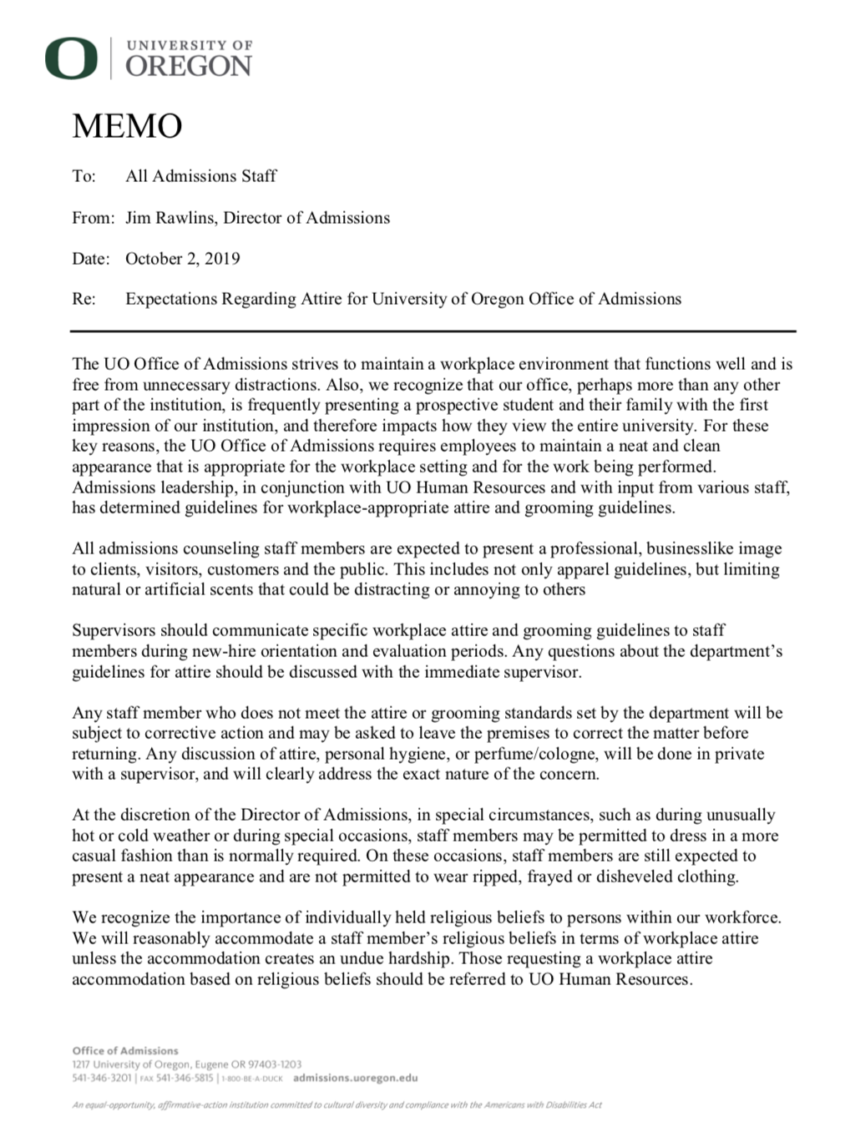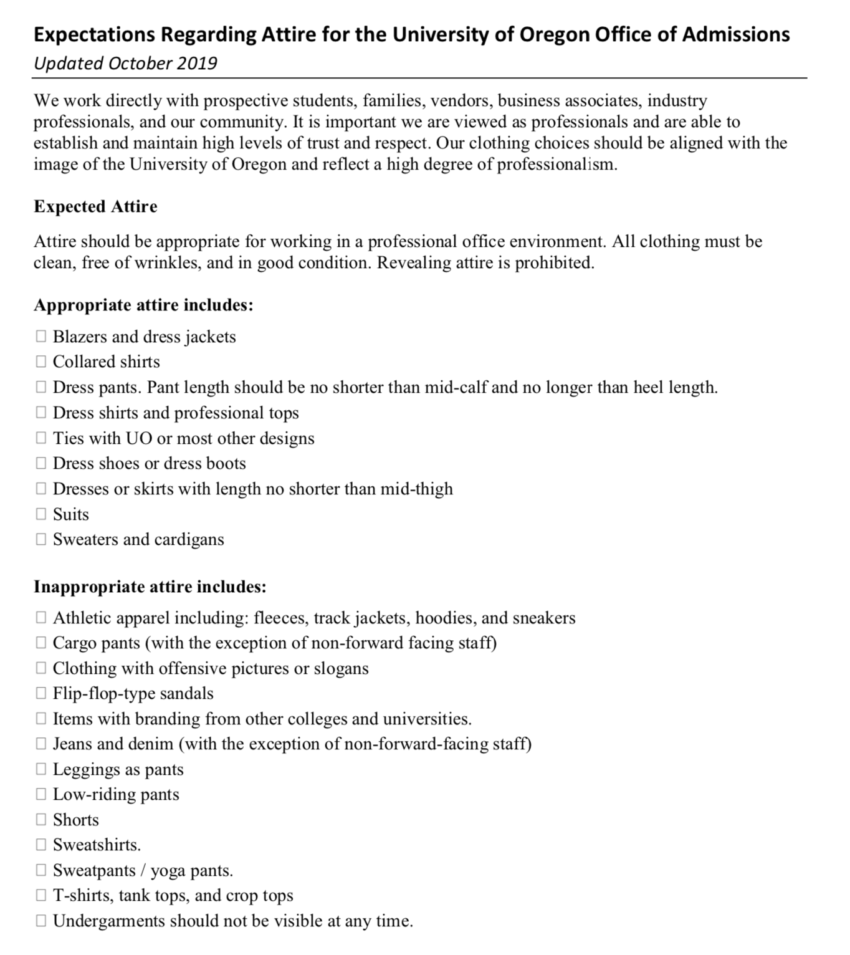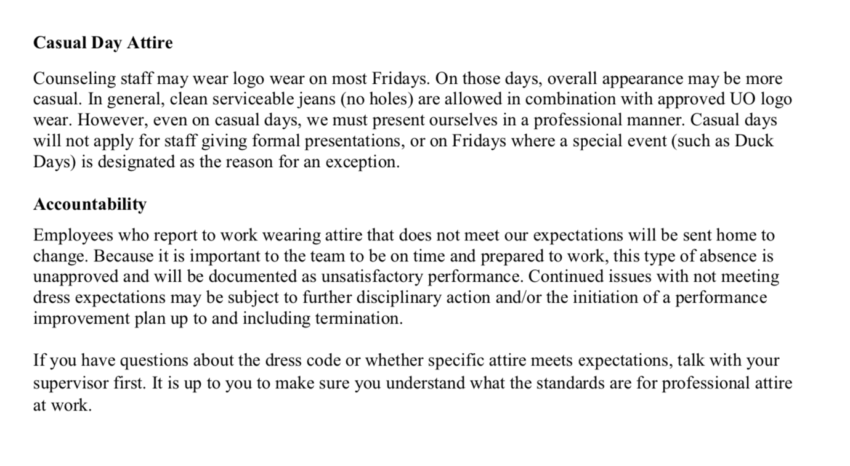I can only speculate as to the offenses which must have inspired this comprehensive code of expectations, but rumor has it they include OSU alumni wearing orange and black ties, and SEIU staff wearing purple:
Thanks to an anonymous reader for the entry. This month’s competition closes on Halloween.



Ah, the dress for success police – I hope they extend this for
faculty attire ….
Banning UW ties I can understand, but OSU ties on casual Friday?
My religion requires me to wear Drakkar Noir, where do I pick up my waiver?
We also impress upon non-forward facing staff the importance of avoiding brussel sprouts, cabbage, or beans at meals prior to working in the UO Admissions office.
Also, there is no provision for appearing naked to work. In fact, we encourage it. Visible undergarments are inappropriate, though.
Butt-cracks anyone?
They clearly haven’t thought this through.
Just to clarify, are students “clients” or “customers”?
(And if the latter, are they always right?)
According the the Standard Industrial Classification system’s input-output tables, students are “inputs” until they graduate, at which point they are shipped as “product”. Before they enroll they should be referred to as “intermediate goods”.
Professional standards are something to be lauded. I’ve had to correct more than one female student worker on appropriate work attire.
Some of our students dress like this institute of learning is a Jersey night club. Kudos for having and holding people to an objective, decent standard.
“Professional standards” might be valuable, but they also deserve scrutiny. When I worked for this same division at UO, they floated the idea that women in the office needed to wear pantyhose. For context, neither Michelle Obama nor women missionaries with the LDS church require hosiery. Nor does the Mayo Clinic. Also, “revealing” is not an objective standard. It’s very much the opposite. What is one “revealing” and to whom?
It is always interesting to me how deeply concerned people are about women’s modesty, and that you only correct your female student workers. Hooray for gender equality, and remind me, what year is it?
I couldn’t agree more. If I’m dressed professionally and my bra strap shows, I shouldn’t have to worry about being sent home, reprimanded, etc. Let’s all pretend women don’t have bodies underneath those clothes! We’ll definitely lose students for that.
Too reminiscent of high school females getting reprimanded and sent home for distracting their male classmates with their clothing.
But sure, the women probably deserve it. They chose to dress that way afterall.
Also – I bet they pay their staff enough money to go buy a new wardrobe to replace their business casual clothes. Ridiculous.
If they feel great dressing like they’re in a Jersey nightclub, I want them to dress that way because I’m a huge fan of people feeling great; also, I guess I’m really hoping you’re kidding, because the idea that you’re correcting your FEMALE students, only, is paternalistic bullshit and should go away how about yesterday or preferably in 1952.
But, more broadly: professional standards and dress codes are not the same thing. Professionalism is about behavior and skills; dress codes are about appearance, on which my hope it is the case that we avoid making judgments. Honestly, I hope several of the people working in admissions (probably for roughly $30K in salary; we pay our financial aid folks, admissions folks, and academic advising folks a pittance) basically quit and explain that they can’t dress like that on their income and also how they dress has jack all to do with their knowledge, skills, and abilities. We hire for knowledge, skills, and abilities, not for wearing particular things that someone somewhere has decided is their aesthetic.
In closing, I hope the pal who wrote this has a very uncomfortable conversation with campus HR this week and spends the weekend and beyond feeling bad about their life choices until and unless they improve.
Time to dig out a Cal sweatshirt for this weekend.
Don’t forget the predetermined halloween costume theme (SSEM has had a traditional costume party) after an apparently “inappropriate” costume one year (I never actually got to see it). Past themes include orange and black for OSU (ohhhh scary…).
I sure hope they plan to give a very large wardrobe stipend to any classified and student workers…
This is ridiculous.
UOM to “Deplorable Duck”: I’ve rejected your “carpet and drapes” and nudist comments. No one doubts that you are truly deplorable. In your revisions please focus on being reasonably amusing.
Here is a picture of Jim Rawlins carrying out his official duties with a visible undergarment:
https://www.klcc.org/post/student-athletes-enhance-campus-and-community
Can we assume that since the university does not tolerate gender discrimination, this be documented as unsatisfactory performance?
I can see his undershirt! Oh the humanity!
I’m not seeing a photo at that link…
Just scroll down after the first large photo
Because students will respond so well to people in outdated and uncomfortable clothing, as opposed to people dressed like them.
When I am working with a “professional” I judge them on their attitude and competence, not their clothes. I thus fail the writer of this memo on the grounds that he or she has an unpleasantly controlling attitude to staff and an unrealistic conception of what matters most to people entering the office.
I do agree with the concept of non-stinky clothes and shoes, and limited or no scent, since people can be made quite ill by perfumes and scented deodorants. The rest sounds like overkill.
I am amazed by the lack of even minimal support for this memo. Sure, it’s a bit over the top, but are you really telling me that if I showed up for work in a ripped t-shirt that said “F*** YOU” on it, but I did really great work, my supervisor is supposed to let that slide? How is that good for anyone?
This is a place of employment; the employer gets to set the standards for how work is conducted, including how people dress while they are at work. As long as the requirements are legal, including accommodations for protected statuses, reasonably affordable (I have purchased all of my collared shirts, and many other clothes that fit these criteria, at thrift stores over the years, for pocket change), and non-discriminatory for protected statuses, what is the problem, exactly?
Disclaimer: I am in my 40s. Maybe I’m just an old fart. My first boss told me it was unprofessional to wear a t-shirt to work, and he was right.
I find it a little uncharitable that you’d render the conversations above, which seem to focus on gender and include a number of points of agreement with the initial memo, down to advocating for a ripped “F You” t-shirt. That’s not really the conversation.
Nor is the conversation really about what’s legal; I don’t think anyone above claimed that it was.
Professional standards have changed a great deal in the last 30 or so years, and they continue to change. (So have the costs at thrift stores, FWIW.) I think it’s perfectly reasonable to invite reflection on why this memo seems resistant to some of the norms of workplace dress elsewhere on campus, and in what ways this memo would invite differential scrutiny toward women.